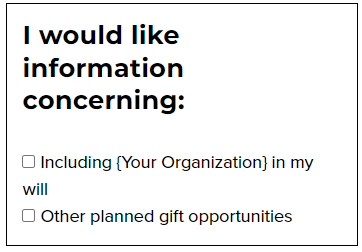Planned Giving Language for Your Response Card That Works
Most organizations add a planned giving checkbox to their response card.
It often reads like this:
Donors rarely check either of these boxes.
So, why include it at all?
Ironically, the number one reason donors name as to why they do not add charity to their wills is:
"It never occurred to me."
Since repetition creates awareness, including a planned giving option on the reply card is a good reminder. But maybe there’s a better way to state it and help donors overcome inertia and take action.
Tom Ahern thinks so. In his presentation Marketing Bequests at the 2012 AFP-MA conference, he pointed out:
“Planned giving” is jargon. Insider talk.
“Bequest” is everyday talk.
Since bequests constitute at 80 to 90 percent of so-called planned gifts, a bequest is what you want to ask for on your reply card.
And making it simple to take action overcomes inertia.
Here are some examples from Tom that are clear, direct, and action-oriented:
Leave a legacy. Please remember {Your Organization} in your will.
All it takes is a quick phone call to your lawyer to add a charitable gift to your will.
If you already have a will, a quick phone call to your attorney is all you’ll need to add a charitable gift.
Five Maples client, Copley Hospital, uses this simple and direct language on their new reply card. Here’s how it reads:
Here’s the logic: It shows the donor how simple it is. The action you really want your donor to take, is to contact their attorney or financial advisor. That’s far more powerful than checking a box to have you contact them. That puts the donor in charge and gets the ball rolling.
And, then they can check a box to let you know they have done so.
Making it simple to act on is what makes an effective donor response card. That’s what I call a donor-centric response card.
They can then can check a box to let you know they have done so.
An effective donor response card makes calls to action(s) simple. That’s what I call a donor-centric response card.
We've got your back!
Learn how to use effective planned giving language for your direct mail fundraising & donation response card, helping donors take action with the right wording. Five Maples helps fundraisers save time, raise more money and enjoy doing it!
Contact us today at garyh@fivemaples.com to learn how Five Maples can boost your planned giving communications.

